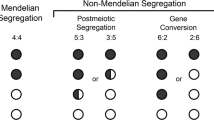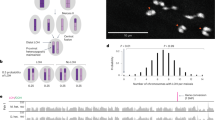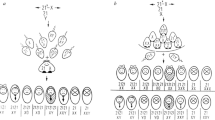Abstract
Recent studies of human oocytes have demonstrated an enrichment for distal exchanges among meiosis I (MI) nondisjunction events and for proximal exchanges among meiosis II (MII) events. Our characterization of 103 cases of spontaneous X chromosome nondisjunction in Drosophila oocytes strongly parallels these observations. The recombinational histories of MI (97/103) and MII (6/103) nondisjunctional ova were strikingly different. MI nondisjunction occurred primarily in oocytes with non–exchange X chromosomes; of the few nondisjoining exchange bivalents, most carried distal crossovers. Thus, spontaneous MI nondisjunction reflects the failure of the achiasmate segregation systems. MII nondisjunction occurred only in oocytes with proximal exchanges. We propose several models to explain how very proximal exchanges might impair proper segregation.
This is a preview of subscription content, access via your institution
Access options
Subscribe to this journal
Receive 12 print issues and online access
$209.00 per year
only $17.42 per issue
Buy this article
- Purchase on SpringerLink
- Instant access to full article PDF
Prices may be subject to local taxes which are calculated during checkout
Similar content being viewed by others
References
Hawley, R.S. et al. There are two mechanisms of achiasmate segregation in Drosophila females, one of which requires heterochromatic homology. Dev. Genet. 13, 440–467 (1993).
Sherman, S.L. et al. Nondisjunction of chromosome 21 in maternal meiosis I: evidence for a maternal age-dependent mechanism involving reduced recombination. Hum. Mol. Genet. 3, 1529–1535 (1994).
MacDonald, M. et al. The origin of 47,XXY and 47,XXX aneuploidy. Hum. Mol. Genet. 3, 1365–1371 (1994).
Theurkauf, W.E. & Hawley, R.S. Meiotic spindle assembly in Drosophila females: behavior of the nonexchange chromosomes and the effects of mutations in the nod kinesin-like protein. J. Cell. Biol. 116, 1167–1180 (1992).
McKim, K.S. & Hawley, R.S. Chromosomal control of meiotic cell division. Science 270, 1595–1601 (1995).
Hawley, R.S., Frazier, J.A. & Rasooly, R. Separation anxiety: the etiology of nondisjunction in flies and people. Hum. Mol. Genet. 3, 1521–1528 (1994).
Bridges, C.B. Non-disjunction as proof of the chromosome theory of heredity. Genetics 1, 1–52 (1916).
Sturtevant, A.M. & Beadle, G.W. The relations of inversions in the X chromosome of Drosophita melanogaster to crossing over and disjunction. Genetics 21, 554–604 (1936).
Hawley, R.S., McKim, K.S. & Arbel, T. Meiotic segregation in Drosophila melanogaster females: molecules, mechanisms, and myths. Annu. Rev. Genet. 27, 281–317 (1993).
Karpen, G.H., Le, M.-H. & Le, H. Centric heterochromatln and the efficiency of achiasmate disjunction in Drosophila female meiosis. Science 273, 118–122 (1996).
Dernburg, A.F., Sedat, J.W. & Hawley, R.S. Direct evidence of a role for heterochromatin in meiotic chromosome segregation. Cell 85, 135–146 (1996).
Merriam, J.R. & Frost, J.N. Exchange and nondisjunction of the X chromosomes in female Drosophila melanogaster . Genetics 49, 109–122 (1964).
Lamb, N. et al. Maternal non-disjunction of chromosome 21 is initiated during meiosis I. Nature Genet. 14, 400–405 (1996).
Weinstein, A. The theory of multiple-strand crossing over. Genetics 21, 155–199 (1936).
Sandler, L., Lindsley, D.L., Nicoletti, B. & Trippa, G. Mutants affecting meiosis in natural populations of Drosophila melanogaster . Genetics 60, 525–558 (1968).
Hartwell, L.H., Dutcher, S.K., Wood, J.S. & Garvik, B. The fidelity of mitotic chromosome reproduction in Saccharomyces cerevisiae . Rec. Adv. Yeast Mol. Biol. 1, 28–38 (1982).
Carpenter, A.T.C. & Baker, B.S. On the control of the distribution of meiotic exchange in Drosophila melanogaster . Genetics 101, 81–89 (1982).
Green, M. Radiation induced reverse mutations in Drosophila melanogaster . Proc. Natl. Acad. Sci. USA 45, 16–18 (1959).
Darlington, C.D. Misdivision and the genetics of the centromere. J. Genet. 37, 341–364 (1939).
Sears, E.R. Misdivision of univalents in common wheat. Chromosoma 4, 535–550 (1952).
Petersen, M.B. et al. Comparative study of microsatellite and cytogenetic markers for detecting the origin of the nondisjoined chromosome 21 in Down Syndrome. Am. J. Hum. Genet. 51, 516–525 (1992).
Hawley, R.S. Exchange and chromosome segregation in eukaryotes. In Genetic Recombination (eds Kucherlapati, R. & Smith, G.) 497–525 (Am. Soc. Microbiol., Washington, D.C., 1988).
Koehler, K.E., Hawley, R.S., Sherman, S. & Hassold, T. Recombination and nondisjunction in humans and flies. Hum. Mol. Genet. 5, 1495–1505 (1996).
Afshar, K., Barton, N.R., Hawley, R.S. & Goldstein, L.S.B. DNA binding and meiotic chromosomal localization of the Drosophila nod kinesin-like protein. Cell 81, 129–138 (1995).
Afshar, K., Scholey, J. & Hawley, R.S. Identification of the chromosome localization domain of the Drosophila nod kinesin-like protein. J. Cell Biol. 131, 833–843 (1995).
Zitron, A.E. & Hawley, R.S. The genetic analysis of distributive segregation in Drosophila mefanogaster. I. Isolation and characterization of Aberrant X segregation (Axs), a mutation defective in chromosome partner choice. Genetics 122, 801–821 (1989).
Hawley, R.S. & Therkauf, W.E. Requiem for the distributive system: achiasmate segregation in Drosophila females. Trends Genet 9, 310–317 (1993).
Knowles, B.A. & Hawley, R.S. Genetic analysis of microtubule motor proteins in Drosophila: a mutation at the ncd locus is a dominant enhancer of nod. Proc. Natl. Acad. Sci. USA 88, 7165–7169 (1991).
Baker, B.S. & Carpenter, A.T.C. Genetic analysis of sex chromosomal meiotic mutants in Drosophila melanogaster . Genetics 71, 255–286 (1972).
O'Tousa, J. Meiotic chromosome behaviour influenced by mutation-altered disjunction in Drosophila melanogaster females. Genetics 102, 503–524 (1982).
Hassold, T.M., Adkins, K., Freeman, S. & Sherman, S. Recombination and maternal age-dependent nondisjunction: molecular studies of trisomy 16. Am. J. Hum. Genet. 57, 867–874 (1995).
Ross, L.O., Maxfield, R. & Dawson, D. Exchanges are not equally able to enhance meiotic chromosome segregation in yeast. Proc. Natl. Acad. Sci. USA 93, 4979–4983 (1996).
Nicklas, R.B. Chromosome segregation mechanisms. Genetics 78, 205–213 (1974).
Angell, R.R., Xian, J., Keith, J., Ledger, W. & Baird, D.T. First meiotic division abnormalities in human oocytes: mechanism of trisomy formation. Cyrogenet. Cell Genet. 65, 194–202 (1994).
Angell, R.R. Meiosis I in human oocytes. Cytogenet. Cell Genet. 69, 266–272 (1995).
Hunt, P., LeMaire, R., Embury, P., Sheean, L. & Mroz, K. Analysis of chromosome behavior in intact mammalian oocytes: monitoring the segregation of a univalent chromosome during female meiosis. Hum. Mol. Genet. 4, 2007–2012 (1995).
Carpenter, A.T.C. A mutant defective in distributive disjunction in Drosophila melanogaster . Genetics 73, 393–428 (1973).
Rasooly, R.S., New, C.M., Zhang, R., Hawley, R.S. & Baker, B.S. The lethal (1)TW-6cs mutation in Drosophila melanogaster is a dominant allele of nod and is associated with a single base pair change in the putative ATP-binding domain. Genetics 129, 409–422 (1991).
Zhang, P., Knowles, B.A., Goldstein, L.S.B. & Hawley, R.S. A kinesin-like protein required for distributive chromosome segregation in Drosophila. Cell 62, 1053–1062 (1990).
Matthies, H.J.G., McDonald, H.B., Goldstein, L.S.B. & Therkauf, W.E. Anastral meiotic spindle morphogenesis: role of the NCD kinesin-like protein. J. Cell Biol. (in the press).
Endow, S.A., Henikoff, S. & Soler-Niedziela, L. Mediation of meiotic and early mitotic chromosome segregation in Drosophila by a protein related to kinesin. Nature 345, 81–83 (1990).
Stewart, R.T., Thaler, J.P. & Goldstein, L.S. Direction of microtubule movement is an intrinsic property of the motor domains of kinesin heavy chain and Drosophila ncd protein. Proc. Natl. Acad. Sci. USA 90, 5209–5213 (1990).
Tokai, N. et al. Kid, a novel kinesin-like DNA binding protein, is localized to chromosomes and the mitotic spindle. EMBO J. 15, 457–467 (1996).
Abruzzo, M. & Hassold, T. Etiology of nondisjunction in humans. Environ. Mol. Mut. Suppl. 25, 38–47 (1995).
White–Cooper, H., Alphey, L. & Glover, D.M. The cdc25 homologue twine is required for only some aspects of the entry into meiosis in Drosophila. J. Cell Science 106, 1035–1044 (1993).
Jang, J.K., Messina, L., Erdman, M.B., Arbel, T. & Hawley, R.S. Induction of metaphase arrest in Drosophila oocytes by chiasma-based kinetochore tension. Science 268, 1917–1919 (1995).
Nicklas, R.B. Chromosome distribution: experiments on cell hybrids and in vitro . Phil. Trans. R. Soc. Lon. 277, 267–276 (1977).
Novitski, E. Genetic measures of centromere activity in Drosophila melanogaster . J. Cell. Comp. Physiol. 45, 151–169 (1955).
Goldstein, L.S.B. Mechanisms of chromosome orientation revealed by two meiotic mutants in Drosophila melanogaster . Chromosoma 78, 79–111 (1980).
Miyazaki, W.Y. & Orr-Weaver, T.L. Sister-chromatid misbehavior in Drosophila ord mutants. Genetics 132, 1047–1061 (1992).
Bickel, S.E., Wyman, D.W., Miyazaki, W.Y., Moore, D.P. & Orr-Weaver, T.L. Identification of ORD, a Drosophila protein essential for sister chromatid cohesion. EMBOJ. 15, 1451–1459 (1996).
Kerrebrock, A.W., Moore, D.P., Wu, J.S. & Orr-Weaver, T.L. Drosophila protein required for sister-chromatid cohesion, can localize to meiotic centromere regions. Cell 83, 247–256 (1995).
Nelson, C.R. & Szauter, P. Timing of mitotic chromosome loss caused by the ncd mutation of Drosophila melanogaster . Cell Motil. Cytoskel. 23, 34–44 (1992).
Zhang, P. & Hawley, R.S. The genetic analysis of distributive segregation in Drosophila melanogaster. II. Further genetic analysis of the nod locus. Genetics 125, 115–127 (1990).
Lindsley, D.L. & Zimm, G.C. The genome of Drosophila melanogaster. (Academic Press, San Diego, USA, 1992).
Author information
Authors and Affiliations
Rights and permissions
About this article
Cite this article
Koehler, K., Boulton, C., Collins, H. et al. Spontaneous X chromosome MI and MII nondisjunction events in Drosophila melanogaster oocytes have different recombinational histories. Nat Genet 14, 406–414 (1996). https://doi.org/10.1038/ng1296-406
Received:
Accepted:
Issue Date:
DOI: https://doi.org/10.1038/ng1296-406



